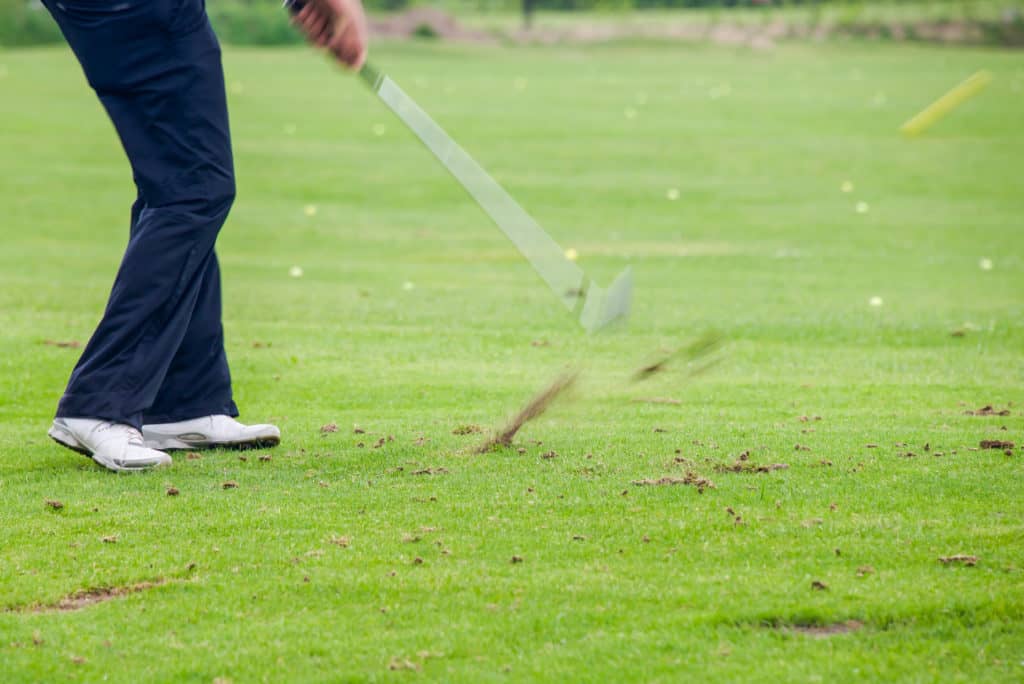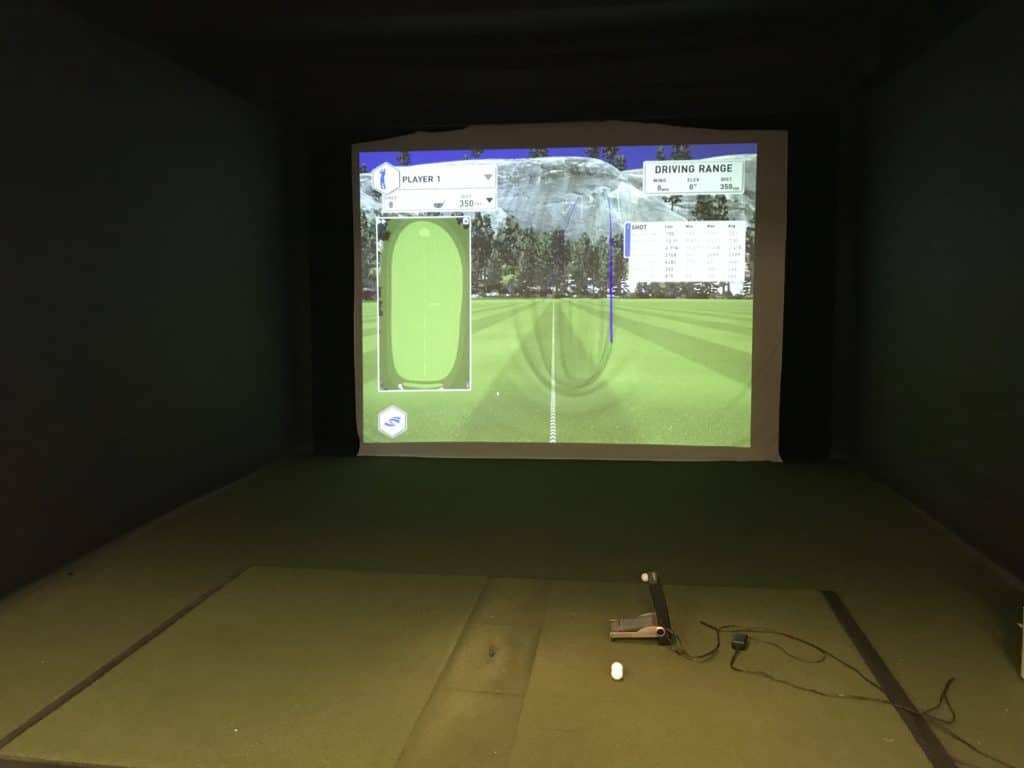Golf can be an addicting game!
You catch the bug and you are always trying to get better. That is what we love about the game of golf!
The journey to get better! The good news is that there are a lot of ways to practice, learn and improve your golf game.
One quality option are wiffle balls.
Are Wiffle Balls Good For Practice?
Yes! Wiffle balls are a quality option for practicing in tight locations. They allow the golfer to work on making solid contact with the ball in addition to working on chip and pitch shots. Hitting the ball solid is a major fundamental of the game and being a great short game player is important. While the flight is different, there are some excellent drills a golfer can use.
The greatest benefit to using wiffle balls is that they can be used in tight locations where you do not have a ton of space. I have hit thousands of chip shots with wiffle balls in my basement over the years and built a technique that transfers to the golf course. I have also spent many hours hitting wiffle balls all around a half acre size lot, working on various parts of my game.
Here are some excellent drills that I would recommend:
- Low Point Control Drill
- Stock Shot Drill
- Tempo Drill
- Chipping Drill
- Controlling Your Curve

Drill #1: Low Point Control Drill
The first fundamental of golf according to the Stack and Tilt Instructors is to be able to control the low point of your golf swing. The best golfers in the world are able to hit precisely where they want on just about every shot they hit in every round they play. While the highest handicap players might only hit several shots a round where they control their low point.
Even as your handicap improves, continuing to work on low point control is essential to getting to the next level. The best golfers are often the best ball strikers and this starts with controlling your low point in the golf swing.
Here the the steps to take to complete this drill:
- Paint a 2-3 yard long line with some yard paint.
- Place the wiffle ball on the line.
- The goal is to have your divot start just on the target side of your line.
- Go ahead and hit shot after shot, working on controlling your low point and your entry into the ground.
- Assess your success rate out of 20 times and write it down.
- Complete this drill daily for several weeks and see if your game improves at the course.
If you start to hit the ball poorly at any point on your golf journey, return to this drill and keep it simple. One quick tip if you are struggling to control your low point, go ahead and set up with 60% of your weight on your front leg. Keep your head centered without a big shift off the ball and turn more around your front leg.
This will help keep your centers in place and allow you to control the low point. Many golfers struggle with the low point because they don’t get their weight back to their front side early enough and end up casting the club.
Resource: Hitting irons for beginners (5 simple steps)
Drill #2: Stock Shot Drill
The 2nd fundamental of golf is to be able to control your start line and the curve of the ball. The stock shot drill is one drill that can be used for the remaining of your time playing the great game of golf. Have you ever played golf and have no idea where the ball is going to start and then curve?
Yes! We have all been there before. This stock shot drill is great to help you visualize and then monitor your success of starting the ball down your intended target line.
Here the the steps to take to complete this drill:
- Set up an alignment stick down your target line about 12-15 feet in front of you.
- Set up a second alignment stick about 2-4 feet right of the first alignment stick.
- Using your wiffle ball, go ahead and attempt to hit the ball through the gate.
- Assess how many times out of 20 you are successful.
- Write this number down and repeat this drill for as long as your play golf.
A realistic number even for the most advanced golfers might be around 15 out of 20. Even the best golfers struggle to hit their start line from time to time. The major benefit of this drill is to have the visuals to allow you to narrow into a specific target. As you get to the golf course, you will be able to visual the alignment sticks in your mind and hit it through that gate.
Resource: How to hit your irons further!

Drill #3: Tempo Drill
Many high handicap golfers struggle with too slow of a backswing. This results in poor sequencing and the golfer struggles to make solid contact. John Novosel Jr. is currently working to help golfers improve their game through tempo work. HIs dad discovered through video that the best golfers have a 3:1 ratio in their swing.
Using a camera and studying the framers per second, he found that many golfers were at one of the following ratios: 21:7, 24:8, 27:9. These are all 3:1 ratios. As a result, he built a time tone to help golfers develop their own 3:1 ratio, which helps with distance and ball contact.
Here the the steps to take to complete this drill:
- Download the Tour Tempo time tone app.
- Record your swing and use other Tour Tempo app to measure your current tempo.
- Go ahead and hit shots using the tone app to train at one of the tempos that are an option.
- Use your wiffle ball to allow you to strike and hit a ball if your space is limited.
The apps are impressive and are worth checking out. There are two apps, one that allows you to record your swing and measure it and the other that allows you to train. You will find that if your backswing is slow and takes a long time that by speeding it up you will produce more distance and likely better contact.
Resource: Tour Tempo Review: Can it help my game?
Drill #4: Chipping Drill
Chipping wiffle balls around your house in a safe area where you won’t break anything is a great option, especially during the winter. I use my basement to keep my short game sharp in the winter. Many golfers struggle to hit solid chip shots consistently. The wiffle balls can provide quality feedback on the height of the shot and the quality of the contact.
Here the the steps to take to complete this drill:
- Get a handful of wiffle balls and hit a variety of shots.
- Work with different clubs and different length shots.
The great news is that it doesn’t take great technique, speed or power to be an awesome short game player. Instead, it takes time and commitment to creating a system that works for your game. The winter is the perfect time to practice the short game for those that live in parts of the world where winter golf is impossible.
Resource: Top 5 Tips for Chipping Better!

Drill #5: Controlling Your Curve
Another major fundamental of golf is being able to control the curve of your golf ball. If one time you hit a draw and the next time a fade without having a clue of what shot is going to come off the club, you might find yourself in some big trouble on the golf course. Instead, if you can develop a shot that you know which way the ball is going to curve 9 times out of 10, you will be far ahead of many golfers.
The ultimate level is to be able to hit a draw or fade on demand, but at first, golfers should strive to hit one stock shot that has a reliable slight curve to the shot.
Here the the steps to take to complete this drill:
- Learn to hit a shot shape by working on that shape for 20-30 swings.
- Once you have reached a certain level, work on curving the ball the other way.
- Once you can curve it both ways, hit 10 and 10 of each.
- The next step is to hit one draw and then one fade and try to do this successfully for 10 consecutive swings, going back and forth.
Resource: Draw vs Fade (Complete Overview)
Want To Take Your Game to the Next Level?
For those that are seeking ways to work on your golf game at your home, have you consider a launch monitor that can be used with something as simple as a mat and next? Or take it to the next level and build a golf simulator? Either way, if you have some extra money to go all in, a launch monitor might be just what you need.
The hours of practice that can occur and the ball striking improvements make the investment worth it! With every swing, you can get the following data:
- Ball Speed
- Spin Rate
- Launch Angle
- Spin Axis
- Carry and Total Distance
This set of data ahead can help you groove a swing, make improvements or develop a stock shot that you have always dreamed about. Ready to take your game to the next level? Check out these 3 quality options below:
Let’s face it, in order to get really good at golf, we must practice frequently. About three years ago, I made the leap and invested in a golf simulator build for my garage.
I went with a SkyTrak Launch Monitor and the TGC software and can now play over 100,000 courses including Augusta, Pebble Beach, Bethpage Black, Whistling Straits. St. Andrews and many other of the top 100 courses in the world.
This golf simulator setup, which is more affordable that you might imagine, has been a game changer. I can now play golf everyday of the year regardless of rain, snow, cold weather or time of day. I can practice or play rounds of golf. I can stand in the 11th fairway at Augusta and with the auto-rewind feature I am able to practice my approach shots from various differences.
It is worth checking out through Rain or Shine Golf as they offer some incredible packages along with financing offers that are difficult to beat.
Resource: SkyTrak Launch Monitor: The Ultimate Game Improvement Tool!

Take Action – What You Can Do Today to Get Better
What does this mean for you? I believe in the following recipe to get better:
1 – Improve your motion in the golf swing by identifying a golf instructor. Here are some options:
Here is a list of golf instructors that we have reviewed:
2 – Train to swing faster and improve your swing speed. Here are some options:
Looking to gain more Speed and Distance in your swing. Two Options:
3 – Understand course strategy and work to break through your next barrier. Here is a series on breaking through:
We have provided guides on how to break 100, 90, 80 and 70. Check out more below, if interested.
4 – Practice Frequently
Did you know that I build a golf simulator in my garage and have played over 500 rounds of golf on my SkyTrak system? It has been a game changer and one worth checking out. Here are some of my other posts on golf simulators frequently asked questions:
- Is a Golf Simulator Worth It?
- How to Build a Golf Simulator?
- What is the Best Golf Simulator?
- Golf Simulator Accessories?
- How to Build a Golf Simulator for under $7000
- Top 11 Reasons to Buy a SkyTrak
- How to Build a Golf Simulator for Under $1000
- Why Build A Golf Simulator?
- What Space is Needed?
- Can A Golf Simulator Improve My Game?
- How Much Does A Golf Simulator Cost?
- Don’t Forget to Check out our 15 best golf swings of all time.
I am an amateur golfer on a journey to get better, enjoy the game as often as possible and share my passion and knowledge with others. I have coached high school golfers at a high level and have a great passion for the game and want to give back. I enjoy learning about the golf swing and am currently studying to be a certified professional golf instructor. Join me in our journey to get better everyday. Thank you for reading!

